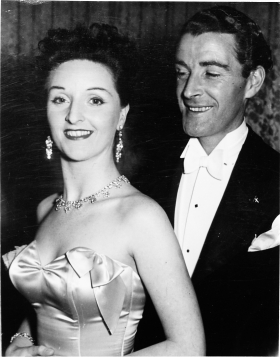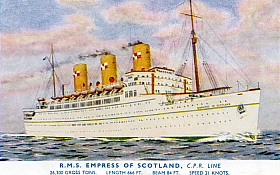1
Ice Skating, Ocean Liners And A Girl From London:
Maisie Tyler About Professional Dancing In The Forties And Fifties.
Text: Kerstin Lange Photography: Portrait Maisie Tyler: Helmut Römhild / Others courtesy of Maisie Tyler.

So I went to Paris, on my own, to meet my dancing partner. It was quite unusual for a young woman to travel alone.
I didn’t speak a word of French or any other foreign language and changing trains was a real adventure.”
The lady is talking about 1947, and a trip from
London to Paris across post war Europe was an
adventure for everyone in those days – not only for a young dancer of 23 on her way to
compete with pairs from 6 countries in the first World Championship after the Second World War.
Maisie Tyler: World Champion and European Champion 1947.
Professional dancer, trainer and owner of Tyler's School of Dancing, Newquay, Cornwall.
Sheer determination and a lot of energy –
that’s what was driving the young woman on the train to Paris.
And
It is there right now while we are talking to Maisie Tyler in her
living room, maybe because she broke her ankle a few weeks ago and now has to somehow
manage everyday life – one more challenge in a life full of challenges,
nothing unusual for a professional dancer.
”I’m so lucky,” she says, smiling. “The hospital is just across the road!
They helped me over and fixed it in no time.”
But of course it is a nuisance for person like Maisie, used to running her dancing school, holding classes every week,
and training competition dancers: One of her pairs just turned professionals.
Her own professional career started at the age of 23. She was living in London when ballroom dancing met ice skating:
“With the war only just being over it was a difficult time. But I loved dancing and right from the start I was quite good at it. By coincidence I met my new dancing partner who was from Switzerland. He was looking for someone who’d like to achieve more in dancing than just having a bit of fun. ”
Meeting Jacques Gerschwiler and becoming his protege was certainly one of the best options for a young dancer to start a career.
Gerschwiler was a gentleman of 48 and already a legend – as a professional trainer of world class ice skaters, turning young talents into top performers.
He had studied sports science in Germany and, living at Richmond, was head coach at the Richmond Ice Rink, the famous ‘Sports Drome’.
and that Jacques Gerschwiler not only applied his successful and scientific training methods to competition dancing but was a dancer himself:
“He was a pro, he trained me, and we were doing so well together that we won the World Championship in Paris, 1947.
After that I did not want to go back to amateursports again.”
When Maisie received certificate and trophy on the dancing floor of the Salle Robinson at Paris in May 1947
it was not only the start of her professional career.
She also represented the new beginning of competition dancing after the Second World War,
underlining the fact that dancing was now among the competitive sports
where first places were the result of systematic training.
And she demonstrated that there was only one true standard of dancing: The ‘English Style’.
The man behind the 1947 World Championship was Camille de Rhynal, famous as a dancing instructor but more famous as ‘event manager’ and impressario.
He started to make money from the Tangomania by organising tango tournaments at the French Riviera, then moved to Paris organising the first series of World Championships.
His enterprise received the death blow by the Great Conference in 1929 when the English dancing instructors defined the standards of modern dancing and by doing so turned
dancing into a competitive sport.
By 1929 Camille de Rhynal’s dancing competitions were ignored: ‘Real’ dancing was taking place in Blackpool and London according to the
standards of the ‘English Style’.
The Second World War brought an end to the development. It was de Rhynal who organised the first competitions after the war and, trying to exploit the post war chaos,
added to the confusion by reviving his own dancing association with the aim to establish it as the top world organisation.
The Forties and Fifties saw a revival of pre-war dancing,
providing mass entertainment in a world where leisure still was a priviledge and
only few of today’s pastimes were available.
It also satisfied the hunger for better times after the war, bringing glamour into everyday life as dancing still represented the lifestyle of the rich and beautiful.
“I was lucky I still lived at my mother’s. So I was able to stick to dancing for a living.
My sister – she was a taylor – did my dresses. You could not buy them in those days.
It was even difficult to find good material for making them yourself. Nevertheless the studios and ballrooms started getting busy again.”
The Hammersmith Palais de Danse, short: Hammersmith Palais, had been one of the major dancing venues since 1919.
Now it was again the place where dancers met.
Maisie: “My favourite place was Hammersmith Palais. That’s where I met my husband, Norman Tyler.”
They were married in 1953, the coronation year of Queen Elizabeth II, and Jacques Gerschwiler asked the Tylers to perform at the Richmond Ice Rink,
turned into ballroom for the coronation celebrations.
There were shows and parties going on everywhere.
We had a ‘Drome Night’ that day attracting a huge crowd. It was simply gorgeous.”
But being a professional dancer became more and more difficult. With new studios and parlours springing up all over London customers had a wide choice where to go and where to learn.
Again it was luck that the Blue Lagoon Ballroom in Newquay
was looking for a pair of ‘resident’ dancers to do shows and teach dancing.
Again it was due to the craft of Maisie and her husband that they were given the contract for the season.
“We loved London and missed it. But the crowds were somewhere else. Thats why we came to Newquay. ‘The Blue Lagoon’ was a famous ballroom in those days.
They were queuing outside.”
Tourism was becoming stronger and stronger and Newquay was an extremely busy seaside resort on the Southwest’s Atlantic coast.
At Newquay’s Blue Lagoon Ballroom there was dancing every evening throughout the season.
On top of that tourists and sometimes even locals gathered for dancing lessons, or to watch performances of pros like the Tylers.
Maisie and Norman apparently made an impression: At the end of the season they were offered a very special contract.
“We were invited to perform on board the ‘Empress of Scotland’ of the Canadian Pacific Line. I’ll remember that trip forever.
The very rich clientele, beautiful ballrooms, dresses, the flair was absolutely brilliant.
Dancing on ships was a favourite pastime. Once hired we were enlisted to the next voyage straight away.”
servicing the transatlantic route Liverpool-Montreal or, during winter, cruising the Caribbean.
“On board the cruise ship we met millionaires like the owner of Ovomaltine and a bookmaker from Manchester. He invited us to perform on his daughter’s birthday. So after the cruise we went up North, stayed in the best hotel in Manchester, did a great show at his home, and had a very good time.”
But times were changing rapidly. Not only did the aera of the ocean liners come to an end,
the ships being replaced in the sixties by the jet plane and high society turning into the jet-set;
also ballroom dancing was no longer the favourite pastime.
“The Atlantic Ocean and Newquay drew a new kind of crowd – the surfers and fans of all kind of watersports.
When dancing became one pastime among many others we started a new business aside: bed and breakfast.”
She quickly adopted to everthing new in her profession, steering the dancing school around many obstacles.
“When the seventies brought the disco-sound we at once took up the new style and offered lessons.
We successfully managed to convince quite a few people that they needed teaching even for this kind of dancing.”
It is late when we leave Maisie Tyler and her white house on top of the hill.
We learned a lot about dancing, and how it was to be a professional in England.
We also learned something about her bookshelf: Yes – there they were, Walter Laird and Guy Howard, giving timeless advice on Latin and Ballroom Dancing.
It had stopped raining and while driving along Trenance Avenue we suddenly have a stunning view across the town of Newquay.
And we think that it would be nice to see dancesport coming back to Newquay again, in grand style – some professional championship, maybe...
![]()
©: Ballroom Website, 2009
Updated: 12.01.2009




